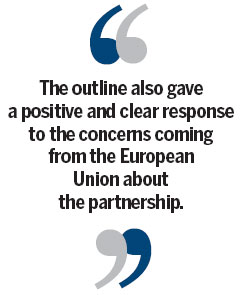Latest reunion builds on past gains
Updated: 2013-11-29 10:29
By Cui Hongjian (China Daily Europe)
|
|||||||||||
Mutual benefit, respect for each other, the cornerstones of China-CEE cooperation
Interactions between China and the 16-member group of Central and Eastern European countries have always been dominated by economic and trade issues that promote mutual growth. The latest round of meetings in Bucharest, Romania, have consolidated the gains of the past and set the tone for further cooperation.
Though China and the CEE countries have had economic ties dating back several years, there was never a political platform to discuss common issues. The idea of a political platform was first suggested at the China-CEE Countries Economic and Trade Forum in Budapest, Hungary in 2011.
In many ways it was also an opportune time for such an alliance. Due to the sovereign debt crisis in Europe, most of the CEE countries were facing turbulent times due to lower economic growth, weak investment and trade prospects, and sovereign debt pressure. Since the EU was more focused on shoring up the euro and rectifying its internal governance, these nations had to look elsewhere for support.
China had by then emerged as the most attractive partner for these CEE countries due to its steady economic growth, rapidly expanding trade and abundant foreign exchange reserves. From a Chinese perspective, the alliance with the CEE group was a sound proposition as it coincided with the upgrade and diversification of its foreign trade. Part of that also included diversifying overseas investment options.
The CEE countries with their friendly political environment, economic complementarities and low investment cost were not only an important emerging market, but also a major investment destination for China.
When leaders from the two sides met in Warsaw last year to discuss common issues, the relationship was cemented further with the Twelve Commitments proposed by China.

Since then both trade and investment levels are higher than in the same period last year and growing more rapidly than overall growth between China and EU.
A special credit line of $10 billion set up by the Twelve Commitments has already become operational. Enterprises from China and CEE countries have reached several cooperation agreements, and China has sent more than 100 trade and investment promotion missions to CEE countries. A series of events under the framework of China-CEE cooperation, including tourism promotion, cultural cooperation forum, educational policy dialogue and forum of local leaders, have been successfully held.
The sincerity and determination of the Chinese government to promote cooperation and the achievements and great potential of pragmatic cooperation have led to the leaders' reunion in Bucharest, mainly for the purpose of reaching further consensus and discussing plans for future cooperation.
Based on experience and results, the mission of the meeting in Bucharest is to make clear the principle of cooperation, establish the framework for it and implement specific areas for cooperative projects. The issuing of Bucharest Outline, the first strategic document of the cooperation, marks the successful completion of the task that embodies the common interests, concerns and aspirations of all parties.
In the outline, all parties affirmed the three principles of their cooperation as "mutual respect, equality and mutual benefit, and win-win cooperation". This is the principle that China has been consistently adhering to in handling international affairs and establishing cooperation with foreign countries, and will be the political principle and the basis of China-CEE cooperation.
Because countries differ in size, political system and economic scale, only by adhering to the three principles can China-CEE cooperation have strong appeal and vitality.
"Promoting investment and trade cooperation" is not the only basis for cooperation. From the declaration of "stand together against protectionism" to "reduce trade imbalances", from "encouraging small and medium enterprises in economic and trade cooperation" to "play a positive role in exploring the third party market jointly", China and CEE countries have stressed that cooperation which respects the concerns and interests of both sides is the best way to tackle the complex and fast-changing global trade and investment situation.
Other important aspects such as the expansion of financial cooperation, science and technology innovation, environmental protection and energy, and an active cultural exchange and cooperation framework have set the tone for enhanced interaction between the two sides.
The outline also gave a positive and clear response to the concerns coming from the European Union about the partnership. "The China-CEE cooperation is a part of the China-EU comprehensive strategic partnership and is complementary," the document said. The former would be one of the growth points and a powerful driving force for further cooperation between China and the EU.
In Bucharest, China, Serbia and Hungary announced jointly the construction of a railway across Hungary and Serbia. China also indicated that it would hold discussions with Romania and other countries about high-speed rail projects. Primer Li Keqiang also used the opportunity to encourage more European exports of agricultural products like beef, milk and wine to China.
There is no doubt that the successful implementation of these cooperative projects will lead to all-round benefits for people from both sides. This is perhaps the true meaning of what Premier Li said when he mentioned that "the effects of China-CEE cooperation is 16+1 which is greater than 17".
The author is director of European Studies at the China Institute of International Studies.
(China Daily European Weekly 11/29/2013 page9)
Today's Top News
Cameron to arrive with big delegation
China launches moon rover
Honor Cairo Declaration
34th high-speed railway starts
Testing time for China's tea growers
8 dead in police helicopter crash onto Glasgow pub
Xi stresses fight against HIV
Premier's trips bear fruit
Hot Topics
Lunar probe , China growth forecasts, Emission rules get tougher, China seen through 'colored lens', International board,
Editor's Picks

|

|

|

|

|

|




